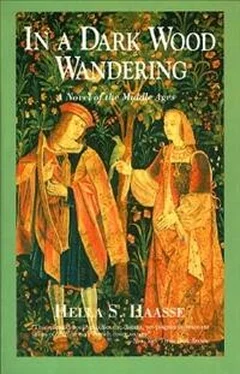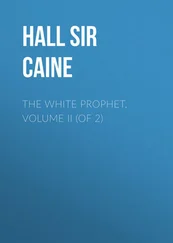Hella Haasse
In a Dark Wood Wandering
This novel, written in Dutch, was first published in the Netherlands in 1949; it has never been out of print. Hella Haasse’s interest in the Middle Ages — and especially in the fifteenth century — had begun when she was a child in Batavia in the Dutch East Indies (now Jakarta, Indonesia). Her attention had been captured when, in 1924 at the age of six, she had seen a portrait of Queen Isabeau in her tall, veiled headdress. At once, she says, “I wanted to know all about that person.” This interest persisted: “While most boys and girls my age were collecting stamps or pictures of film stars, I collected books, articles and pictures about the Middle Ages.” In 1938 or ’39, while she was a student at the University of Amsterdam, she came by chance across an edition in the library of a collection of the poems of Charles d’Orléans, and everything she had read and thought about the fifteenth century crystallized around him.
During the German occupation, Hella Haasse chose to leave the University, where she had been studying Scandinavian languages and literature, rather than sign a statement of loyalty to the Reich, as all students there were required to do. She went instead to the Amsterdam Academy of Dramatic Art and, upon graduation in 1943, joined a theatrical company managed by Cees Laseur, one of Holland’s foremost actors — but only for a short time: the war was too overwhelming. She turned instead to research into the life and times of Charles d’Orléans and after the war began a play on that theme which grew into this novel.
In the fall of 1945 her first book, a volume of poetry, was published, and in 1947 her first work of fiction appeared: Oeroeg, a novella about the relationship between a Dutch and a Javanese youth. The success of this book — about 300,000 copies are now in print — encouraged its Dutch publisher to issue the massive medieval novel entitled Het woud der verwachting: literally, the Forest of Long Awaiting, a metaphor popular with medieval poets and one used by Charles d’Orléans himself. The book was hailed immediately by Dutch literary critics as a major work. In 1950, in a review in English in the Times Literary Supplement, it was called “monumental”, scholarly and admirably lucid, with characters which “take their place as living human beings”.
At this point the scene shifts to Chicago, where Lewis C. Kaplan was working as a postal clerk, a job he had held since 1939 when he left the WPA Federal Writers Project. The Chicago post office at that time was a haven for literary refugees from the Depression; Mr. Kaplan worked with Nelson Algren, Jack Conroy, Willard Motley and the future Chicago bookseller Stuart Brent. Mr. Kaplan’s first love was translation. His method was to spend many months with dictionaries and grammar books and then to embark on the translation of works which he deemed worthwhile and which otherwise would not be available to the English-speaking world. In this way he had translated three novels from the Portuguese: Enrico Verissimo’s Crossroads and The Rest is Silence, published by Macmillan in 1943 and 1946 respectively, and Graciliano Ramos’s Anguish, brought out by Knopf in 1946. In the early fifties, Mr. Kaplan had begun to familiarize himself with Dutch. Through his job in the post office, he had access to foreign periodicals and he scanned the Dutch reviews in search of worthwhile material for translation. In 1953 he came across comments on Het woud der verwachting and was attracted to it not only because the reviews were universally enthusiastic, but because it appeared to be a work of epic dimensions and he preferred large canvases.
Mr. Kaplan contacted Hella Haasse through Querido, her Dutch publisher, who passed his letter on to her; they added that they knew Mr. Kaplan: he was a German refugee who had worked for a time, after the war, in their offices as an editor and had then moved to England. Accordingly, the author gave Mr. Kaplan her blessing. Mr. Kaplan, who had been born in Chicago in 1911 and had lived there all his life, and had never implied otherwise, set to work immediately upon receipt of the Dutch volume, unaware that the people at Querido had apparently confused him with another Kaplan. He worked steadily every evening and on weekends, although his health was not good; his heart had been affected by a childhood attack of rheumatic fever. Within five years, but with no further contact with Hella Haasse, he had completed his first draft of the book. In 1958, when he had revised the first 150 pages more or less to his satisfaction, he became very ill. The night before he was hospitalized, he stood — too sick to sit or lie down — using the television set as a desk in his small Chicago lake-front apartment, still at work on the manuscript. A few days later, he was dead.
His widow, understandably distraught, disposed of all his effects. His Dutch books she donated to Deering Library at Northwestern University; the manuscript itself, which had no title page or identification of any kind, she put in a black briefcase which she stowed at the back of a closet where it was to remain for twenty years. During that time Hella Haasse thought occasionally of Mr. Kaplan and the English version of Het woud der verwachting ; it seemed to her that he was taking a considerable time to complete his work, but she knew that he had tackled a formidable task and, with commendable sensitivity, she hesitated to give him the impression that he was being rushed. Her writing career and her role as the mother of two daughters were taking all her attention; in 1959 she received one of two International Atlantic awards for Literature from the Atlantic Cultural Commission of NATO; in that twenty years she produced at least a dozen novels and she had achieved a reputation as one of the Netherlands’ foremost authors, and was to go on to win many more prizes and honors.
In the late 1970s a fire broke out in the Kaplan apartment. Mrs. Kaplan enlisted the help of her son Kalman, who at the time was a research assistant and guest lecturer at Harvard University, to clean up the ensuing mess. In the course of clearing out a closet, Kalman Kaplan came across the black briefcase and asked his mother about its sopping contents. Mrs. Kaplan knew only that it was the work her husband had been doing before he died. Dr. Kaplan dried out the sheets with some difficulty, and then attempted to find out what this manuscript was since, as we have said, it was untitled and had no author’s name. He sent it off to a publisher in Michigan who responded that it appeared to be some sort of saga, like The Thorn Birds or Gone With the Wind. But they did not publish fiction.
Fortunately, shortly after this, Mrs. Kaplan came up with a piece of paper with “Hella Haasse” written on it. Dr. Kaplan, now armed with a name, telephoned the Library of Congress, who gave him the Dutch title and the Dutch publisher. This was in 1979. Although he contacted Querido immediately, Dr. Kaplan did not hear from the author until 1982; some confusion had apparently resulted from a change of directors at Querido and because Hella Haasse had been in the process of moving from Holland to France. In the meantime, Dr. Kaplan copyrighted his father’s manuscript under the title The Forest of Expectations. Finally, in 1982 Hella Haasse gave Dr. Kaplan permission to market the translation, subject to her approval of it.
At this time Dr. Kaplan was teaching in the psychology department of Wayne State University in Detroit. On a visit to his mother in Chicago, he happened to see an article in The Chicago Tribune about our publishing house. He phoned me, and I told him to bring the manuscript to us so we could look at it. Dr. Kaplan carried a cardboard carton up to our offices in the old Mandel Building on the Chicago River; it contained an 1100-page manuscript divided into five or six sections, each section held together at the top by two large metal rings. He gave me also a separate manuscript of the first seventy-five pages of the book cleanly typed, because his father’s pages were basically worksheets: it had been Lewis Kaplan’s practice to look up Dutch words and type their English definitions on each line, often with snatches of Dutch; when he went back for his revision, he crossed out the words he had decided not to use; occasionally he crossed them all out and wrote the chosen word above them, or added a possible alternative in handwriting in the margin. This of course made the translation very difficult to read.
Читать дальше












